www.down100.cn
The NetWorks .....................................................................................................................................2
Birth of the Net...........................................................................................................................2
How the Web Works ...................................................................................................................2
Some Web History......................................................................................................................3
Understanding Web Addresses................................................................................................... 3
Domain Names........................................................................................................................... 5
About Modem.............................................................................................................................6
Speed It Up................................................................................................................................. 7
Cable Modems............................................................................................................................7
DSL .............................................................................................................................................8
Websites......................................................................................................................................8
Home Sweet Home Page ............................................................................................................8
A Home (Page) of Your Own..................................................................................................... 9
Decoding Error Messages ........................................................................................................ 10
Web Browsers...........................................................................................................................12
网 络 ................................................................................................................................................ 14
网络的诞生.............................................................................................................................. 14
网络是如何工作的 .................................................................................................................. 14
一些网络的历史...................................................................................................................... 15
网 址 ........................................................................................................................................ 15
域 名 ........................................................................................................................................ 16
关于调制解调器...................................................................................................................... 17
加 速...................................................................................................................................... 18
凯布尔调制解调器 .................................................................................................................. 18
DSL ...........................................................................................................................................19
网页(站)....................................................................................................................................19
网页透视 .................................................................................................................................. 19
个人主页 .................................................................................................................................. 20
错误信息分析 .......................................................................................................................... 21
DNS 失败检索................................................................................................................. 22
主机不可用: .................................................................................................................. 22
主机未知:...................................................................................................................... 22
不能定位主机 .................................................................................................................. 22
不能定位服务器.............................................................................................................. 22
�
www.down100.cn
The NetWorks
Birth of the Net
The Internet has had a relatively brief, but explosive history so far. It grew out of an experiment
begun in the 1960's by the U.S. Department of Defense. The DoD wanted to create a computer
network that would continue to function in the event of a disaster, such as a nuclear war. If part of
the network were damaged or destroyed, the rest of the system still had to work. That network was
ARPANET, which linked U.S. scientific and academic researchers. It was the forerunner of today's
Internet.
In 1985, the National Science Foundation (NSF) created NSFNET, a series of networks for
research and education communication. Based on ARPANET protocols, the NSFNET created a
national backbone service, provided free to any U.S. research and educational institution. At the
same time, regional networks were created to link individual
institutions with the national
backbone service.
NSFNET grew rapidly as people discovered its potential, and as new software
applications were created to make access easier. Corporations such as Sprint and MCI began to
build their own networks, which they linked to NSFNET. As commercial firms and other regional
network providers have taken over the operation of the major Internet arteries, NSF has withdrawn
from the backbone business.
NSF also coordinated a service called InterNIC, which registered all addresses on the Internet
so that data could be routed to the right system. This service has now been taken over by Network
Solutions, Inc., in cooperation with NSF.
How the Web Works
The World Wide Web, the graphical portion of the Internet, is the most popular part of the Internet
by far. Once you spend time on the Web,you will begin to feel like there is no limit to what you
can discover. The Web allows rich and diverse communication by displaying text, graphics,
animation, photos, sound and video.
So just what is this miraculous creation? The Web physically consists of your personal
computer, web browser software, a connection to an Internet service provider, computers called
servers that host digital data and routers and switches to direct the flow of information.
The Web is known as a client-server system. Your computer is the client; the remote
computers that store electronic files are the servers. Here's how it works:
Let's say you want to pay a visit to the the Louvre museum website. First you enter the
�
www.down100.cn
address or URL of the website in your web browser (more about this shortly). Then your browser
requests the web page from the web server that hosts the Louvre's site. The Louvre's server sends
the data over the Internet to your computer. Your web browser interprets the data, displaying it on
your computer screen.
The Louvre's website also has links to the sites of other museums, such as the Vatican
Museum. When you click your mouse on a link, you access the web server for the Vatican
Museum.
The "glue" that holds the Web together is called hypertext and hyperlinks. This feature allow
electronic files on the Web to be linked so you can easily jump between them. On the Web, you
navigate through pages of information based on what interests you at that particular moment,
commonly known as browsing or surfing the Net.
To access the Web you need web browser software, such as Netscape Navigator or Microsoft
Internet Explorer. How does your web browser distinguish between web pages and other files on
the Internet? Web pages are written in a computer language called Hypertext Markup Language or
HTML.
Some Web History
The World Wide Web (WWW) was originally developed in 1990 at CERN,
the European
Laboratory for Particle Physics. It is now managed by The World Wide Web Consortium, also
known as the World Wide Web Initiative.
The WWW Consortium is funded by a large number of corporate members, including AT&T,
Adobe Systems, Inc., Microsoft Corporation and Sun Microsystems, Inc. Its purpose is to promote
the growth of the Web by developing technical specifications and reference software that will be
freely available to everyone. The Consortium is run by MIT with INRIA (The French National
Institute for Research in Computer Science) acting as European host, in collaboration with CERN.
The National Center for Supercomputing Applications (NCSA) at the University of Illinois at
Urbana-Champaign, was instrumental in the development of early graphical software utilizing the
World Wide Web features created by CERN. NCSA focuses on improving the productivity of
researchers by providing software for scientific modeling, analysis, and visualization. The World
Wide Web was an obvious way to fulfill that mission. NCSA Mosaic, one of the earliest web
browsers, was distributed free to the public. It led directly to the phenomenal growth of the World
Wide Web.
Understanding Web Addresses
You can think of the World Wide Web as a network of electronic files stored on computers all
around the world. Hypertext links these resources together. Uniform Resource Locators or URLs
are the addresses used to locate these files. The information contained in a URL gives you the
�
www.down100.cn
ability to jump from one web page to another with just a click of your mouse. When you type a
URL into your browser or click on a hypertext link, your browser is sending a request to a remote
computer to download a file.
What does a typical URL look like? Here are some examples:
http://english.chinaschool.net/
The home page for study english.
ftp://rtfm.mit.edu/pub/
A directory of files at MIT* available for downloading.
news:rec.gardens.roses
A newsgroup on rose gardening.
The first part of a URL (before the two slashes* tells you the type of resource or method of
http - a hypertext document or directory
gopher - a gopher document or menu
ftp - a file available for downloading or a directory of such files
news - a newsgroup
telnet - a computer system that you can log into over the Internet
access at that address. For example:
•
•
•
•
•
• WAIS* - a database or document in a Wide Area Information Search database
•
file - a file located on a local drive (your hard drive)
The second part is typically the address of the computer where the data or service is located.
Additional parts may specify the names of files, the port to connect to, or the text to search for in a
database.
You can enter the URL of a site by typing it into the Location bar of your web browser, just
under the toolbar.
Most browsers record URLs that you want to use again, by adding them to a special menu. In
Netscape Navigator, it's called Bookmarks. In Microsoft Explorer, it's called Favorites. Once you
add a URL to your list, you can return to that web page simply by clicking on the name in your list,
instead of retyping the entire URL.
A URL usually has no spaces.
A URL always uses forward slashes (//).
Most of the URLs you will be using start with http which stands for Hypertext Transfer
Protocol*. http is the method by which HTML files are transferred over the Web. Here are some
other important things to know about URLs:
•
•
If you enter a URL incorrectly, your browser will not be able to locate the site or resource you
want. Should you get an error message or the wrong site, make sure you typed the address
correctly.
You can find the URL behind any link by passing your mouse cursor over the link. The pointer
will turn into a hand and the URL will appear in the browser's status bar, usually located at the
bottom of your screen.
�
www.down100.cn
Domain Names
When you think of the Internet, you probably think of ".com." Just what do those three letters at
the end of a World Wide Web address mean?
Every computer that hosts data on the Internet has a unique numerical address. For example, the
numerical address for the White House is 198.137.240.100. But since few people want to
remember long strings of numbers, the Domain Name System (DNS)* was developed. DNS, a
critical part of the Internet's technical infrastructure*, correlates* a numerical address to a word.
To access the White House website, you could type its number into the address box of your web
browser. But most people prefer to use "www.whitehouse.gov." In this case, the domain name is
whitehouse.gov.
In general, the three-letter domain name suffix* is known as a generic top-level domain and
describes the type of organization. In the last few years, the lines have somewhat blurred* between
these categories.
.com - business (commercial)
.edu - educational
.org - non-profit
.mil - military
.net - network provider
.gov - government
A domain name always has two or more parts separated by dots and typically consists of some
form of an organization's name and the three-letter suffix. For example, the domain name for IBM
is "ibm.com"; the United Nations is "un.org."
If a domain name is available, and provided it does not infringe* on an existing trademark, anyone
can register the name for $35 a year through Network Solutions, Inc., which is authorized to
register .com, .net and .org domains. You can use the box below to see if a name is a available.
Don't be surprised if the .com name you want is already taken, however. Of the over 8 million
domain names, 85% are .com domains.
ICANN, the Internet Corporation for Assigned Names and Numbers, manages the Domain Name
System. As of this writing, there are plans to add additional top-level domains, such as .web
and .store. When that will actually happen is anybody's guess.
To check for, or register a domain name, type it into the search box.
It should take this form: myname.com
In addition to the generic top-level domains, 244 national top-level domains were established for
countries and territories*, for example:
.au - Australia
.ca - Canada
.fr - France
.de - Germany
.uk - United Kingdom
For US $275 per name, you can also register an international domain name with Net Names. Be
aware that some countries have restrictions for registering names.
If you plan to register your own domain name, whether it's a .com or not, keep these tips in mind:
The shorter the name, the better. (But it should reflect your family name, interest or business.)
�
www.down100.cn
The name should be easy to remember.
It should be easy to type without making mistakes.
Remember, the Internet is global. Ideally, a domain name will "read" in a language other than
English.
About Modem
Telephone lines were designed to carry the human voice, not electronic data from a computer.
Modems were invented to convert digital computer signals into a form that allows them to travel
over the phone lines. Those are the scratchy sounds you hear from a modem's speaker. A modem
on the other end of the line can understand it and convert the sounds back into digital information
that
can
for
MOdulator/DEModulator.
the word modem stands
understand. By
the
computer
the way,
Buying and using a modem used to be relatively easy. Not too long ago, almost all modems
transferred data at a rate of 2400 Bps (bits per second). Today, modems not only run faster, they
are also loaded with features like error control and data compression. So, in addition to converting
and interpreting signals, modems also act like traffic cops, monitoring and regulating the flow of
information. That way, one computer doesn't send information until the receiving computer is
ready for it. Each of these features, modulation, error control, and data compression, requires a
separate kind of protocol and that's what some of those terms you see like V.32, V.32bis, V.42bis
and MNP5 refer to.
If your computer didn't come with an internal modem, consider buying an external one, because it
is much easier to install and operate. For example, when your modem gets stuck (not an unusual
occurrence), you need to turn it off and on to get it working properly. With an internal modem, that
means restarting your computer--a waste of time. With an external modem it's as easy as flipping a
switch.
Here's a tip for you: in most areas, if you have Call Waiting, you can disable it by inserting
*70 in front of the number you dial to connect to the Internet (or any online service). This will
prevent an incoming call from accidentally kicking you off the line.
This table illustrates the relative difference in data transmission speeds for different
types of files. A modem's speed is measured in bits per second (bps). A 14.4 modem sends data at
14,400 bits per second. A 28.8 modem is twice as fast, sending and receiving data at a rate of
28,800 bits per second.
Until nearly the end of 1995, the conventional wisdom was that 28.8 Kbps was about the fastest
speed you could squeeze out of a regular copper telephone line. Today, you can buy 33.6 Kbps
modems, and modems that are capable of 56 Kbps. The key question for you, is knowing what
speed modems your Internet service provider (ISP) has. If your ISP has only 28.8 Kbps modems
on its end of the line, you could have the fastest modem in the world, and only be able to connect
at 28.8 Kbps. Before you invest in a 33.6 Kbps or a 56 Kbps modem, make sure your ISP supports
them.
�
www.down100.cn
Speed It Up
There are faster ways to transmit data by using an ISDN or leased line. In many parts of the U.S.,
phone companies are offering home ISDN at less than $30 a month. ISDN requires a so-called
ISDN adapter instead of a modem, and a phone line with a special connection that allows it to
send and receive digital signals. You have to arrange with your phone company to have this
equipment installed. For more about ISDN, visit Dan Kegel's ISDN Page.
An ISDN line has a data transfer rate of between 57,600 bits per second and 128,000 bits per
second, which is at least double the rate of a 28.8 Kbps modem. Leased lines come in two
configurations: T1 and T3. A T1 line offers a data transfer rate of 1.54 million bits per second.
Unlike ISDN, a T-1 line is a dedicated connection, meaning that it is permanently connected to the
Internet. This is useful for web servers or other computers that need to be connected to the Internet
all the time. It is possible to lease only a portion of a T-1 line using one of two systems: fractional
T-1 or Frame Relay. You can lease them in blocks ranging from 128 Kbps to 1.5 Mbps. The
differences are not worth going into in detail, but fractional T-1 will be more expensive at the
slower available speeds and Frame Relay will be slightly more expensive as you approach the full
T-1 speed of 1.5 Mbps. A T-3 line is significantly faster, at 45 million bits per second. The
backbone of the Internet consists of T-3 lines.
Leased lines are very expensive and are generally only used by companies whose business is built
around the Internet or need to transfer massive amounts of data. ISDN, on the other hand, is
available in some cities for a very reasonable price. Not all phone companies offer residential
ISDN service. Check with your local phone company for availability in your area.
Cable Modems
A relatively new development is a device that provides high-speed Internet access via a cable TV
network. With speeds of up to 36 Mbps, cable modems can download data in seconds that might
take fifty times longer with a dial-up connection. Because it works with your TV cable, it doesn't
tie up a telephone line. Best of all, it's always on, so there is no need to connect--no more busy
signals! This service is now available in some cities in the United States and Europe.
The download times in the table above are relative and are meant to give you a general idea
of how long it would take to download different sized files at different connection speeds, under
the best of circumstances. Many things can interfere with the speed of your file transfer. These can
range from excessive line noise on your telephone line and the speed of the web server from
which you are downloading files, to the number of other people who are simultaneously trying to
access the same file or other files in the same directory.
�
www.down100.cn
DSL
DSL (Digital Subscriber Line)
is another high-speed technology that
is becoming
increasingly popular. DSL lines are always connected to the Internet, so you don't need to dial-up.
Typically, data can be transferred at rates up to 1.544 Mbps downstream and about 128 Kbps
upstream over ordinary telephone lines. Since a DSL line carries both voice and data, you don't
have to install another phone line. You can use your existing line to establish DSL service,
provided service is available in your area and you are within the specified distance from the
telephone company's central switching office.
DSL service requires a special modem. Prices for equipment, DSL installation and monthly
service can vary considerably, so check with your local phone company and Internet service
provider. The good news is that prices are coming down as competition heats up.
Websites
Anatomy of a Web Page
A web page is an electronic document written in a computer language called HTML, short for
Hypertext Markup Language. Each web page has a unique address, called a URL* or Uniform
Resource Locator, which identifies its location on the network.
A website has one or more related web pages, depending on how it's designed. Web pages on a site
are linked together through a system of hyperlinks* , enabling you to jump between them by
clicking on a link. On the Web, you navigate through pages of information according to your
interests.
Home Sweet Home Page
When you browse the World Wide Web you'll see the term home page often. Think of a home
page as the starting point of a website. Like the table of contents of a book or magazine, the home
page usually provides an overview of what you'll find at the website. A site can have one page,
many pages or a few long ones, depending on how it's designed. If there isn't a lot of information,
the home page may be the only page. But usually you will find at least a few other pages.
Web pages vary wildly in design and content, but most use a traditional magazine format. At the
top of the page is a masthead* or banner graphic*, then a list of items, such as articles, often with
a brief description. The items in the list usually link to other pages on the website, or to other sites.
Sometimes these links are highlighted* words in the body of the text, or are arranged in a list, like
an index. They can also be a combination* of both. A web page can also have images that link to
other content.
How can you tell which text are links? Text links appear in a different color from the rest of the
�

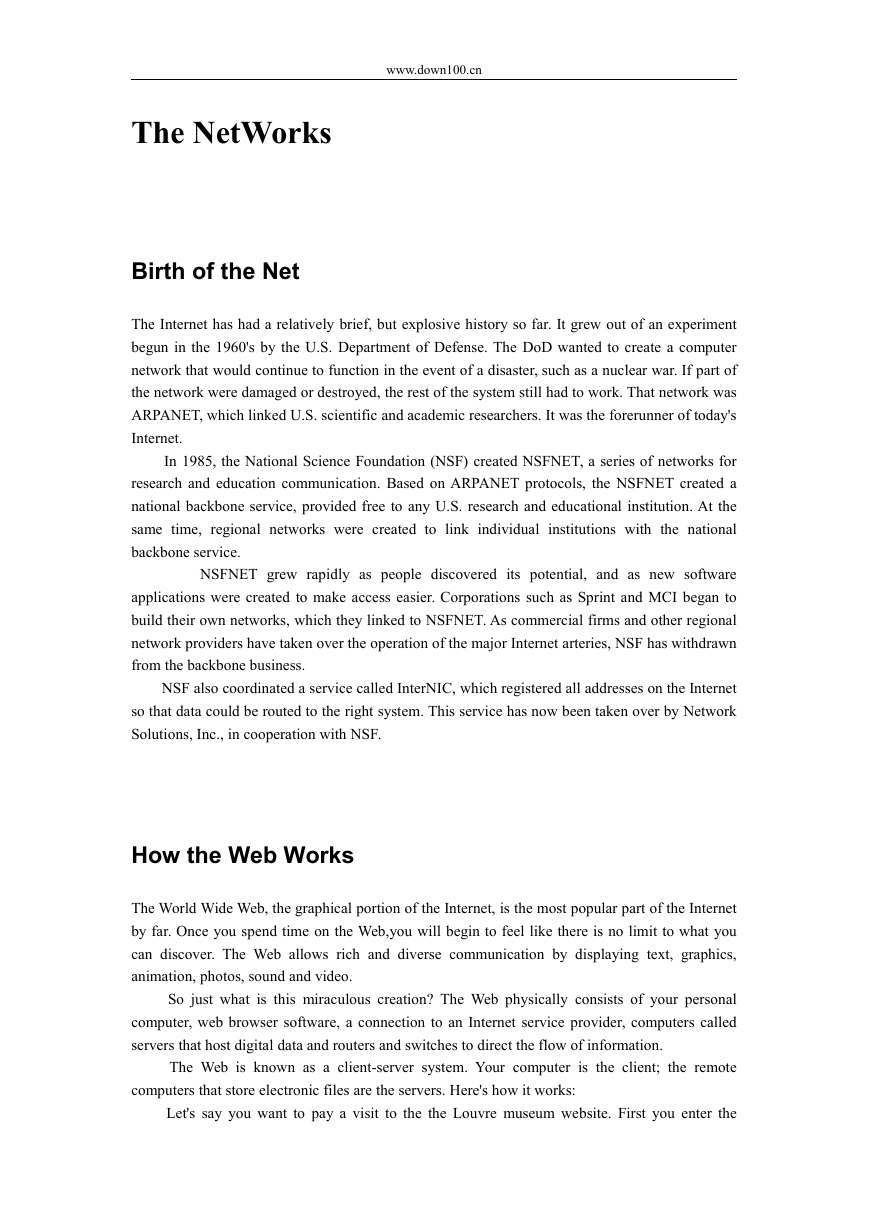
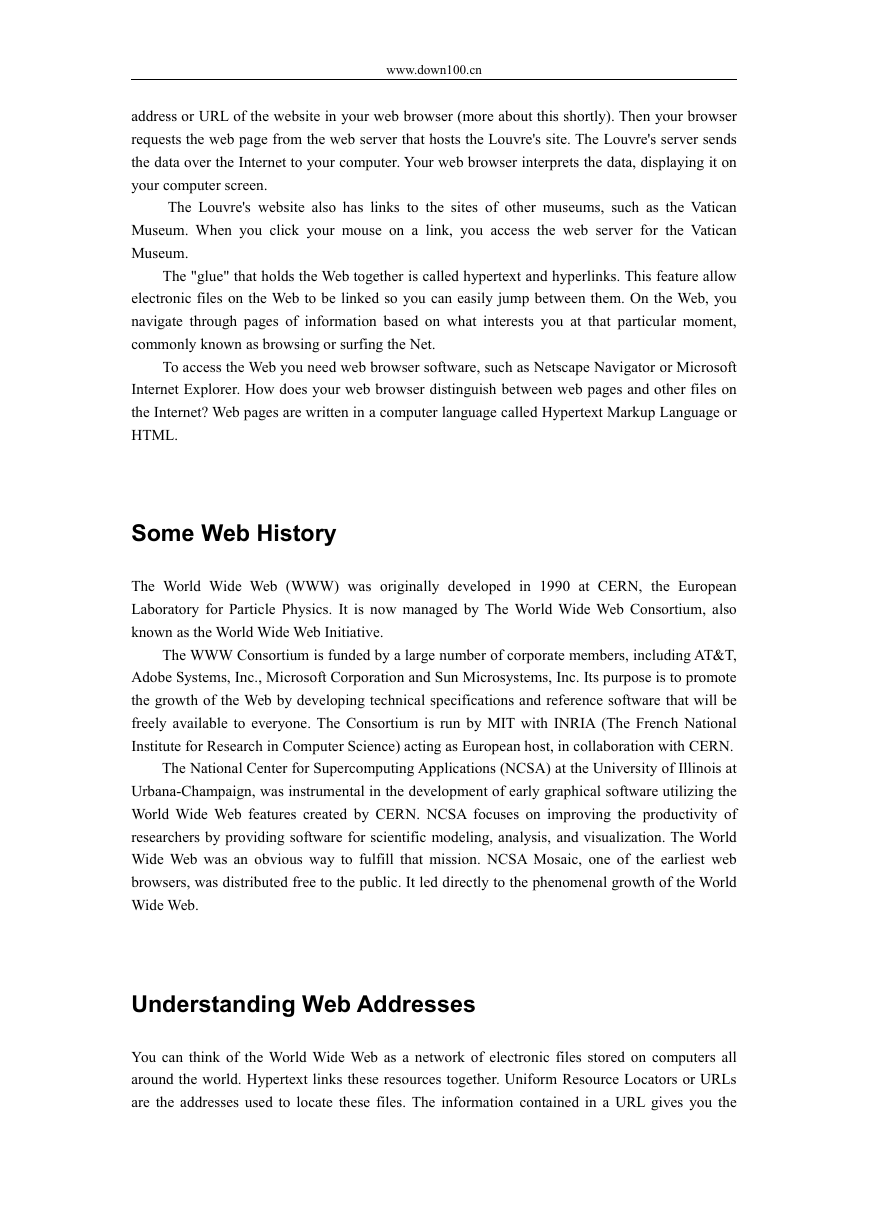
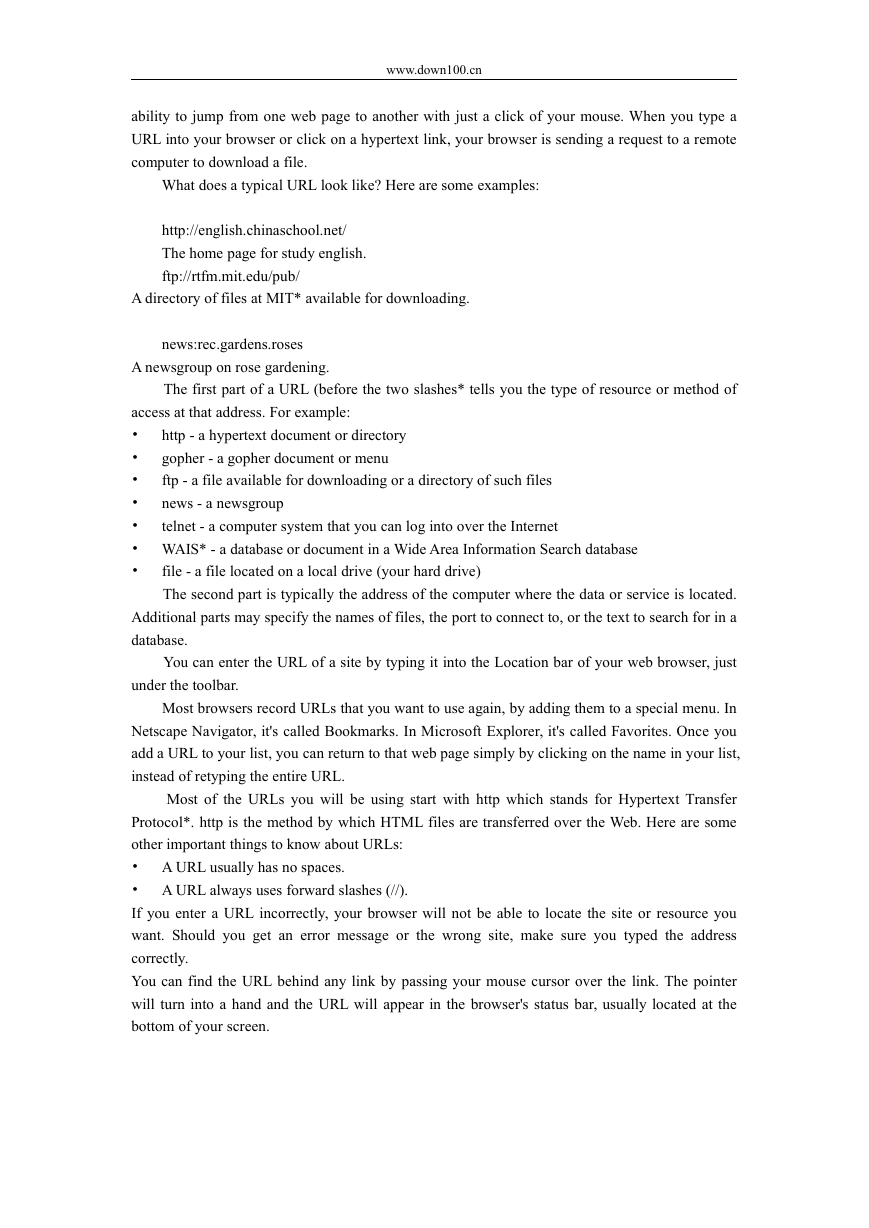
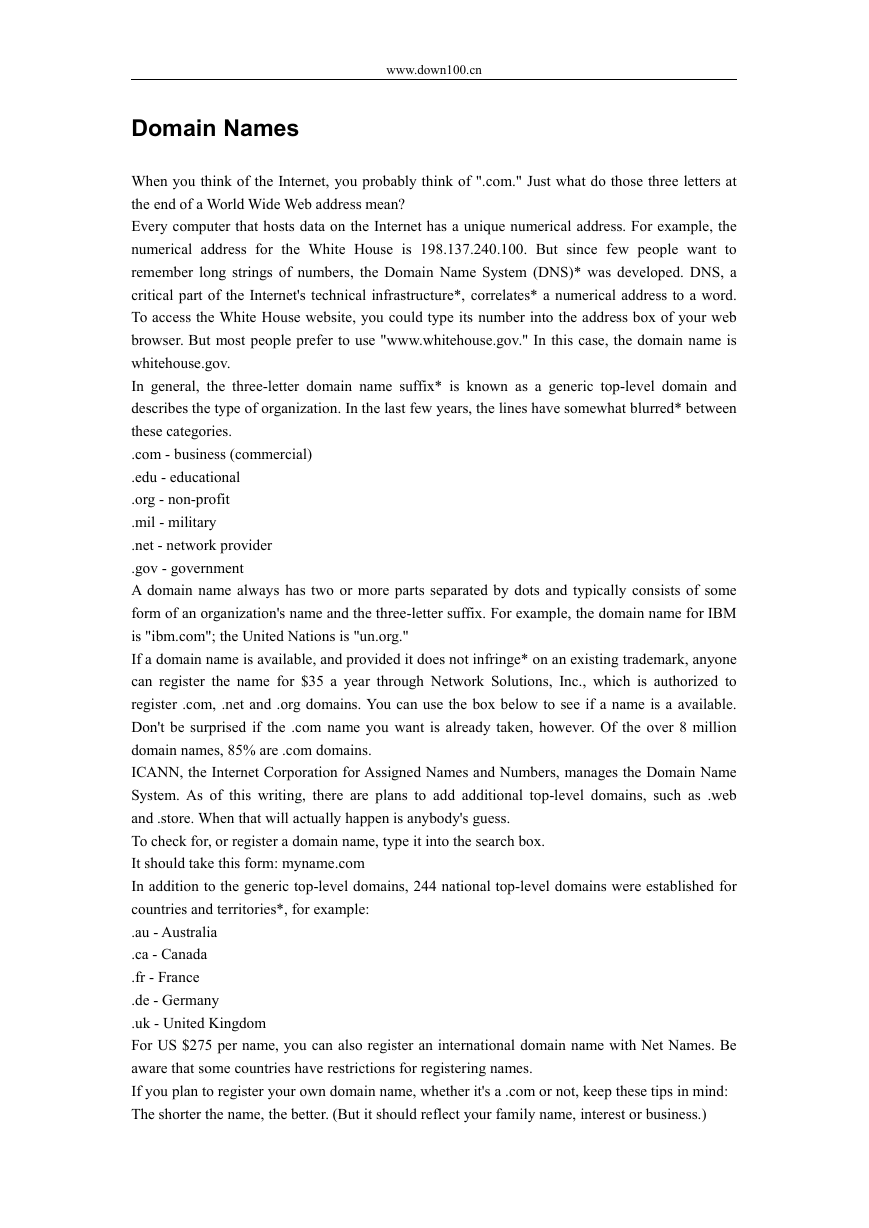
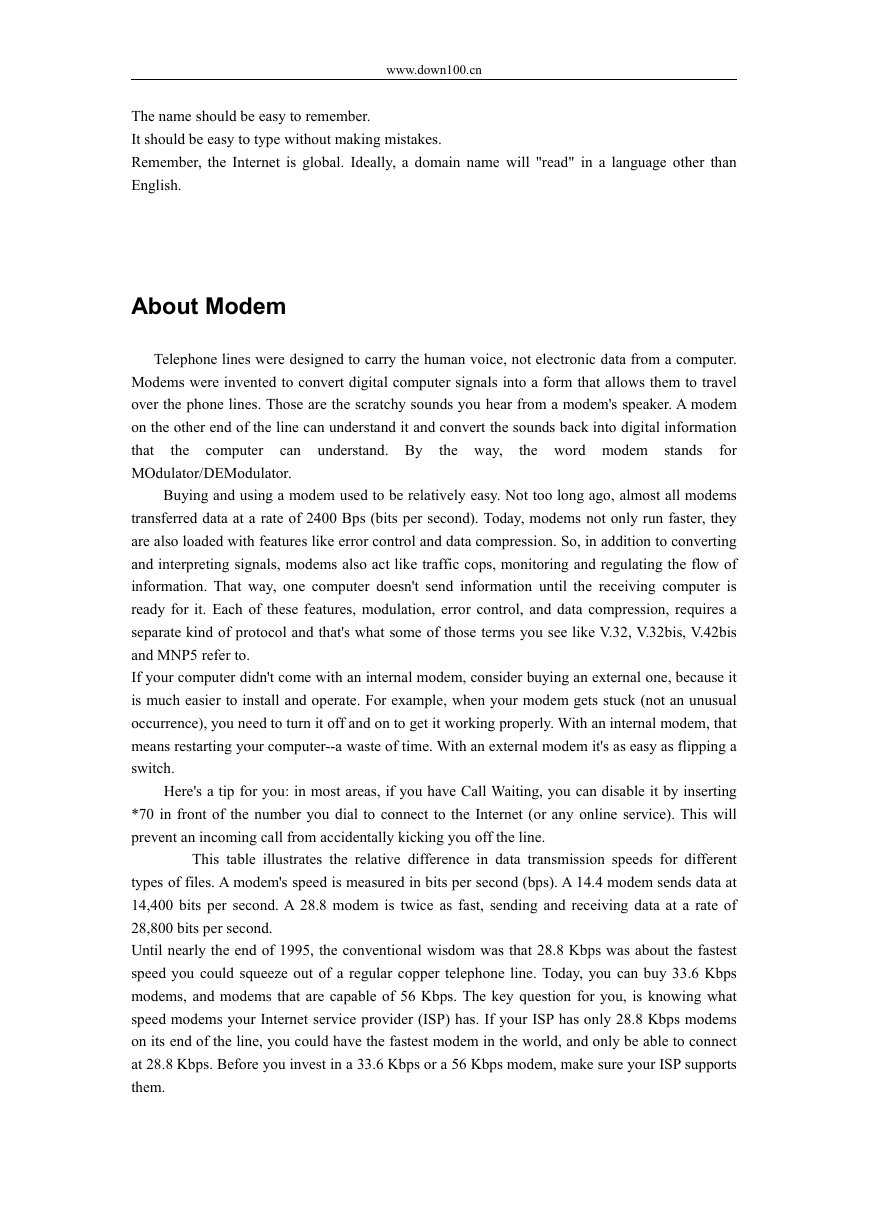
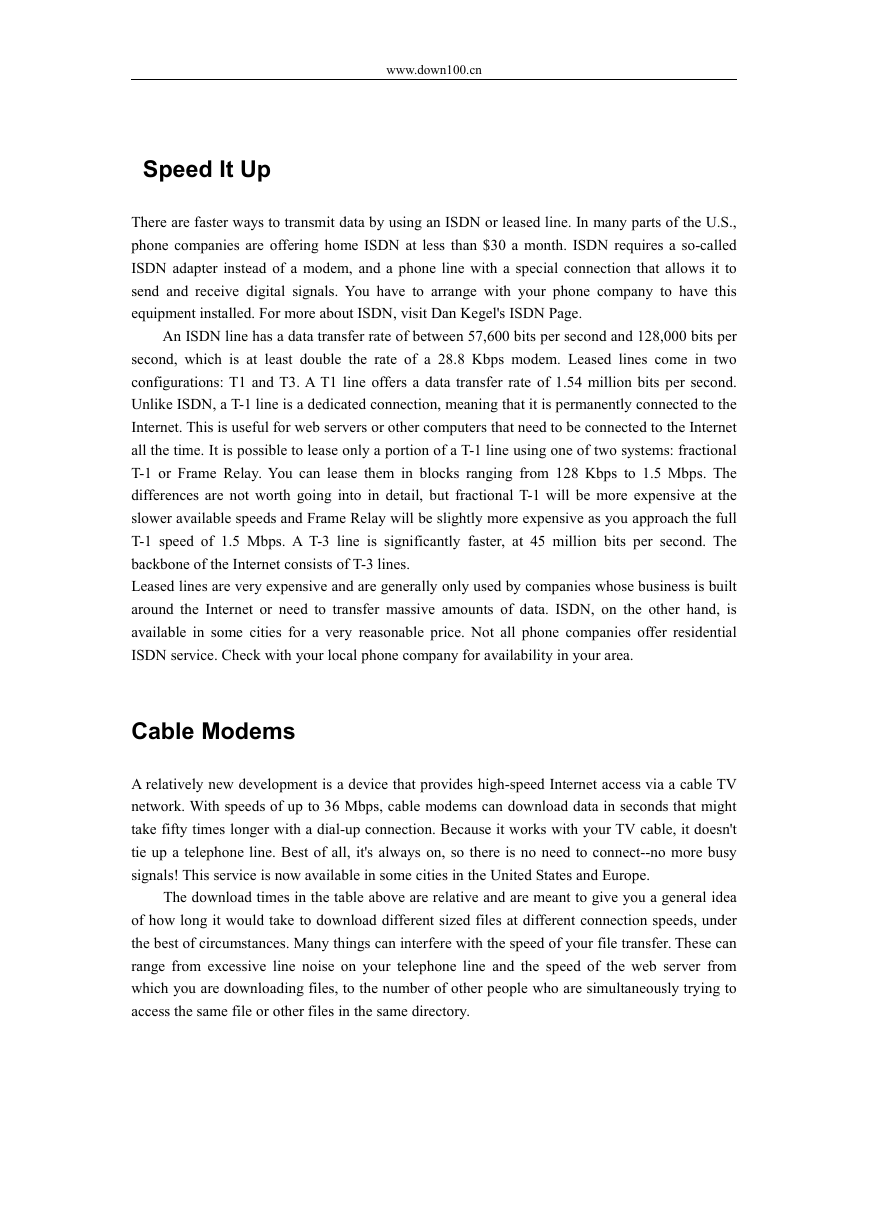
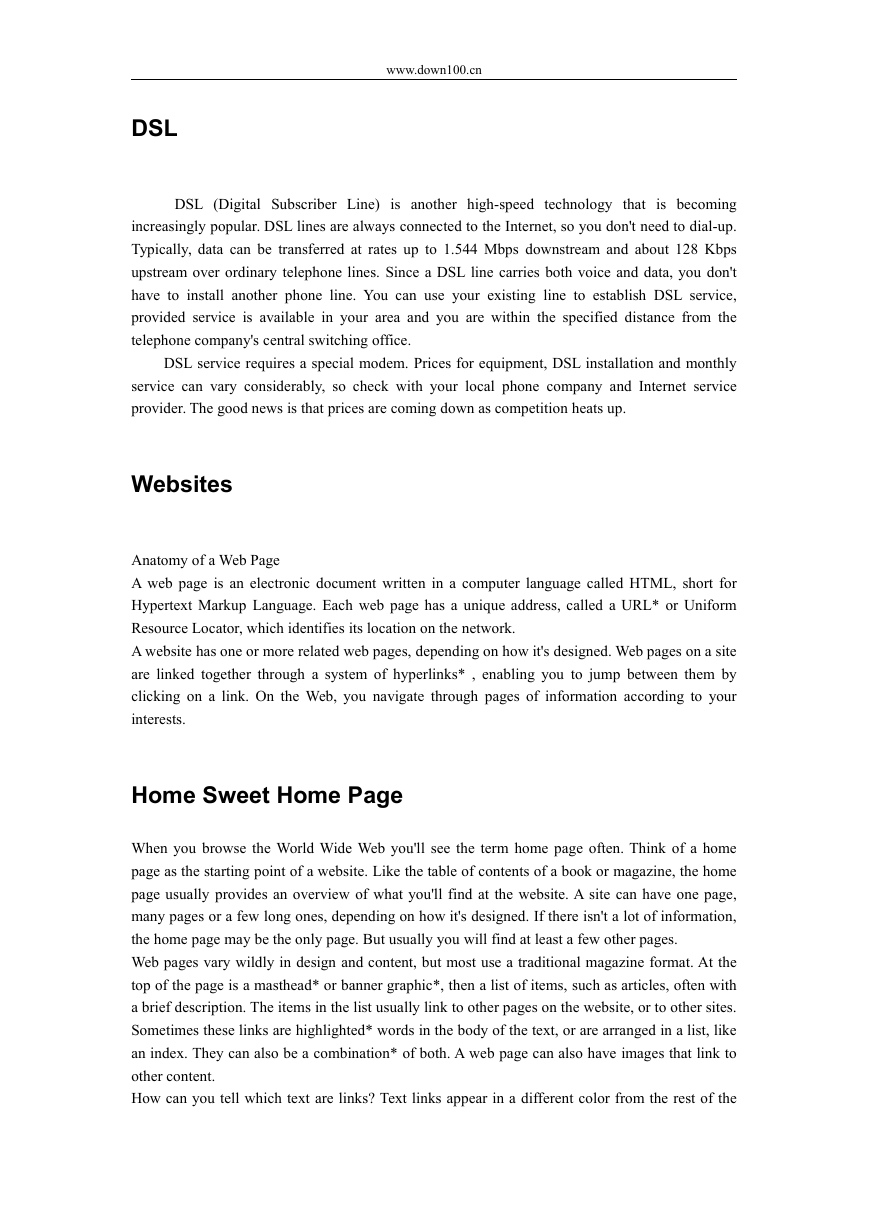








 2023年江西萍乡中考道德与法治真题及答案.doc
2023年江西萍乡中考道德与法治真题及答案.doc 2012年重庆南川中考生物真题及答案.doc
2012年重庆南川中考生物真题及答案.doc 2013年江西师范大学地理学综合及文艺理论基础考研真题.doc
2013年江西师范大学地理学综合及文艺理论基础考研真题.doc 2020年四川甘孜小升初语文真题及答案I卷.doc
2020年四川甘孜小升初语文真题及答案I卷.doc 2020年注册岩土工程师专业基础考试真题及答案.doc
2020年注册岩土工程师专业基础考试真题及答案.doc 2023-2024学年福建省厦门市九年级上学期数学月考试题及答案.doc
2023-2024学年福建省厦门市九年级上学期数学月考试题及答案.doc 2021-2022学年辽宁省沈阳市大东区九年级上学期语文期末试题及答案.doc
2021-2022学年辽宁省沈阳市大东区九年级上学期语文期末试题及答案.doc 2022-2023学年北京东城区初三第一学期物理期末试卷及答案.doc
2022-2023学年北京东城区初三第一学期物理期末试卷及答案.doc 2018上半年江西教师资格初中地理学科知识与教学能力真题及答案.doc
2018上半年江西教师资格初中地理学科知识与教学能力真题及答案.doc 2012年河北国家公务员申论考试真题及答案-省级.doc
2012年河北国家公务员申论考试真题及答案-省级.doc 2020-2021学年江苏省扬州市江都区邵樊片九年级上学期数学第一次质量检测试题及答案.doc
2020-2021学年江苏省扬州市江都区邵樊片九年级上学期数学第一次质量检测试题及答案.doc 2022下半年黑龙江教师资格证中学综合素质真题及答案.doc
2022下半年黑龙江教师资格证中学综合素质真题及答案.doc